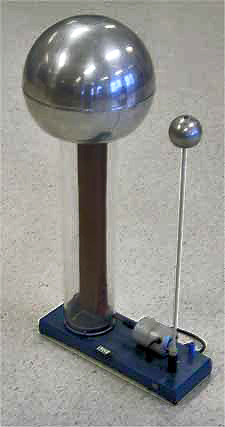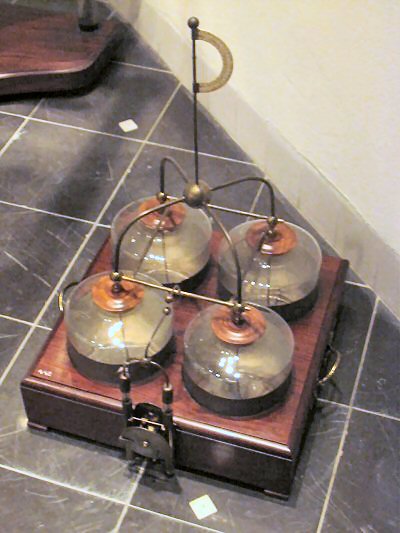|
Large Electrostatic Generator (Teylers)
The large electrostatic generator (Dutch: ''Van Marum electriseermachine'') is a large handcrafted electromechanical instrument designed by Martin van Marum and built by John Cuthbertson in 1784 for the Teylers Museum in Haarlem, where it forms the centerpiece of the instrument room. The concept of an electrostatic generator was new, and the battery (array) of leiden jars was the largest ever built (only one of the 4 sets of leiden jars is on display to conserve space). The two glass disks of the triboelectric generator (friction generator) are 1.65 meters in diameter, and the machine is capable of generating a potential of 330,000 volts. History The device is a larger version of a similar model built in Groningen by Gerhard Kuyper in 1774 for physics student Martin van Marum, who used it to make a name for himself in the study of electricity with his lectures and demonstrations. It was Van Marum's dream to create a larger version, and he applied to the Teylers Stichting in ... [...More Info...] [...Related Items...] OR: [Wikipedia] [Google] [Baidu] |
Interior Instrument Room Teylers Museum
Interior may refer to: Arts and media * ''Interior'' (Degas) (also known as ''The Rape''), painting by Edgar Degas * ''Interior'' (play), 1895 play by Belgian playwright Maurice Maeterlinck * ''The Interior'' (novel), by Lisa See * Interior design, the trade of designing an architectural interior Places * Interior, South Dakota * Interior, Washington * Interior Township, Michigan * British Columbia Interior, commonly known as "The Interior" Government agencies * Interior ministry, sometimes called the ministry of home affairs * United States Department of the Interior Other uses * Interior (topology), mathematical concept that includes, for example, the inside of a shape * Interior FC, a football team in Gambia See also * * * List of geographic interiors * Interiors (other) * Inter (other) * Inside (other) Inside may refer to: * Insider, a member of any group of people of limited number and generally restricted access Film * ''Inside'' ... [...More Info...] [...Related Items...] OR: [Wikipedia] [Google] [Baidu] |
Martin Van Marum
Martin(us) van Marum (20 March 1750, Delft – 26 December 1837, Haarlem) was a Dutch physician, inventor, scientist and teacher, who studied medicine and philosophy in Groningen. Van Marum introduced modern chemistry in the Netherlands after the theories of Lavoisier, and several scientific applications for general use. He became famous for his demonstrations with instruments, most notable the '' Large electricity machine'', to show statical electricity and chemical experiments while curator for the Teylers Museum. Biography Early career Born in Delft, Van Marum moved to Haarlem in 1776 ''because the Haarlemmers had more taste in the sciences than anywhere else in the Netherlands.'' After his arrival in Haarlem he began to practise medicine, but devoted himself mainly to lecturing on physical subjects and creating instruments to demonstrate physical theory. He must have made a big impression on Haarlem society, because he became a member of the Dutch Society of Science in ... [...More Info...] [...Related Items...] OR: [Wikipedia] [Google] [Baidu] |
John Cuthbertson (instrument Maker)
John Cuthbertson (bapt. 1 July 1743 in Dearham – 1821) was an English instrument maker and inventor that lived from 1768 until roughly 1796 in Amsterdam. Biography John was the second son of the inn keeper and yeoman Jonathan Cuthbertson and his second wife Mary Fisher. John had three siblings, of which two survived (a younger brother Jonathan (1744–1806) and one other): the third died at young age (Jonathan, the eldest). John and the younger brother Jonathan are often confused in literature and publications. While John worked for a long time in Amsterdam, Jonathan worked n Rotterdam, both in the same line of work. John studied with the prominent London instrument maker James Champneys and when Champney moved to Amsterdamaccording to some sources after a bankruptcy: other sources deny this (Bryden 1977) in December 1768 Cuthbertson joined him. On 1 September 1768 John had married Champney's daughter Jane. They had four children, three sons and a daughter, but only the daught ... [...More Info...] [...Related Items...] OR: [Wikipedia] [Google] [Baidu] |
Teylers Museum
Teylers Museum () is an art, natural history, and science museum in Haarlem, Netherlands. Established in 1778, Teylers Museum was founded as a centre for contemporary art and science. The historic centre of the museum is the neoclassical Oval Room (1784), which was built behind the house of Pieter Teyler van der Hulst (1702–1778), the so-called ''Fundatiehuis'' (Foundation House). Pieter Teyler was a wealthy cloth merchant and banker of Scottish descent, who bequeathed his fortune for the advancement of religion, art, and science. He was a Mennonite and follower of the Scottish Enlightenment. History In his will, Pieter Teyler stipulated that his collection and part of his fortune should be used to establish a foundation for their promotion: Teylers Stichting. The Teyler legacy to the city of Haarlem was split into two societies: Teylers First or Theological Society (Dutch: ''Teylers Eerste of Godgeleerd Genootschap''), intended for the study of religion and Teylers Second ... [...More Info...] [...Related Items...] OR: [Wikipedia] [Google] [Baidu] |
Teylers Instrument Room
The Instrument Room is a room in Teylers Museum which houses a part of the museum's ''Cabinet of Physics'': a collection of scientific instruments from the 18th and 19th centuries. The instruments in the collection were used for research as well as for educational public demonstrations. Most of them are demonstration models that illustrate various aspects of electricity, acoustics, light, magnetism, thermodynamics, and weights and measures. The rest are high-quality precision instruments that were used for research. History of the room Originally all of the museum's collections were housed in the Oval Room from 1784. The electricity instrument demonstrations tended to make a lot of noise and distracted the readers of the books in the gallery, and after the mineralogical cabinet was built for the center of the room, demonstrations there became more difficult and a new demonstration and lecture room was built on the north side (today the Print room). This new room shared its purpose ... [...More Info...] [...Related Items...] OR: [Wikipedia] [Google] [Baidu] |
Electrostatic Generator
An electrostatic generator, or electrostatic machine, is an electrical generator that produces '' static electricity'', or electricity at high voltage and low continuous current. The knowledge of static electricity dates back to the earliest civilizations, but for millennia it remained merely an interesting and mystifying phenomenon, without a theory to explain its behavior and often confused with magnetism. By the end of the 17th century, researchers had developed practical means of generating electricity by friction, but the development of electrostatic machines did not begin in earnest until the 18th century, when they became fundamental instruments in the studies about the new science of electricity. Electrostatic generators operate by using manual (or other) power to transform mechanical work into electric energy, or using electric currents. Manual electrostatic generators develop electrostatic charges of opposite signs rendered to two conductors, using only electric forces ... [...More Info...] [...Related Items...] OR: [Wikipedia] [Google] [Baidu] |
Leiden Jar
A Leyden jar (or Leiden jar, or archaically, sometimes Kleistian jar) is an electrical component that stores a high-voltage electric charge (from an external source) between electrical conductors on the inside and outside of a glass jar. It typically consists of a glass jar with metal foil cemented to the inside and the outside surfaces, and a metal terminal projecting vertically through the jar lid to make contact with the inner foil. It was the original form of capacitor (also called a ''condenser''). Its invention was a discovery made independently by German cleric Ewald Georg von Kleist on 11 October 1745 and by Dutch scientist Pieter van Musschenbroek of Leiden (Leyden), Netherlands in 1745–1746. The Leyden jar was used to conduct many early experiments in electricity, and its discovery was of fundamental importance in the study of electrostatics. It was the first means of accumulating and preserving electric charge in large quantities that could be discharged at the exp ... [...More Info...] [...Related Items...] OR: [Wikipedia] [Google] [Baidu] |
Triboelectric Effect
The triboelectric effect (also known as triboelectric charging) is a type of contact electrification on which certain materials become electrically charged after they are separated from a different material with which they were in contact. Rubbing the two materials with each other increases the contact between their surfaces, and hence the triboelectric effect. Rubbing glass with fur for example, or a plastic comb through the hair, can build up triboelectricity. Most everyday static electricity is triboelectric. The polarity and strength of the charges produced differ according to the materials, surface roughness, temperature, strain, and other properties. The triboelectric effect is very unpredictable, and only broad generalizations can be made. Amber, for example, can acquire an electric charge by contact and separation (or friction) with a material like wool. This property was first recorded by Thales of Miletus. The word "electricity" is derived from William Gilbert's initi ... [...More Info...] [...Related Items...] OR: [Wikipedia] [Google] [Baidu] |
Groningen
Groningen (; gos, Grunn or ) is the capital city and main municipality of Groningen province in the Netherlands. The ''capital of the north'', Groningen is the largest place as well as the economic and cultural centre of the northern part of the country; as of December 2021, it had 235,287 inhabitants, making it the sixth largest city/municipality of the Netherlands and the second largest outside the Randstad. Groningen was established more than 950 years ago and gained city rights in 1245. Due to its relatively isolated location from the then successive Dutch centres of power (Utrecht, The Hague, Brussels), Groningen was historically reliant on itself and nearby regions. As a Hanseatic city, it was part of the North German trade network, but later it mainly became a regional market centre. At the height of its power in the 15th century, Groningen could be considered an independent city-state and it remained autonomous until the French era. Today Groningen is a university ci ... [...More Info...] [...Related Items...] OR: [Wikipedia] [Google] [Baidu] |
Teylers Stichting
The Teylers Stichting (English: Teylers Foundation) is a Dutch foundation founded with the heritage of the Dutch 18th century cloth merchant and banker Pieter Teyler van der Hulst to support the people in need and encourage worship, science and art (''ter ondersteuning van behoeftigen en ter aanmoediging van godsdienst, wetenschap'').description of Teylers Stichting on the website of Teylers Museum (Dutch) History When Teyler deceased in 1778, he was without children or direct family, and specified in his testament how his money was to be spent. He left money for several individuals, the church and the general benefit as described above. Claims have been made by alleged family members that the testame ...[...More Info...] [...Related Items...] OR: [Wikipedia] [Google] [Baidu] |

.jpg)




